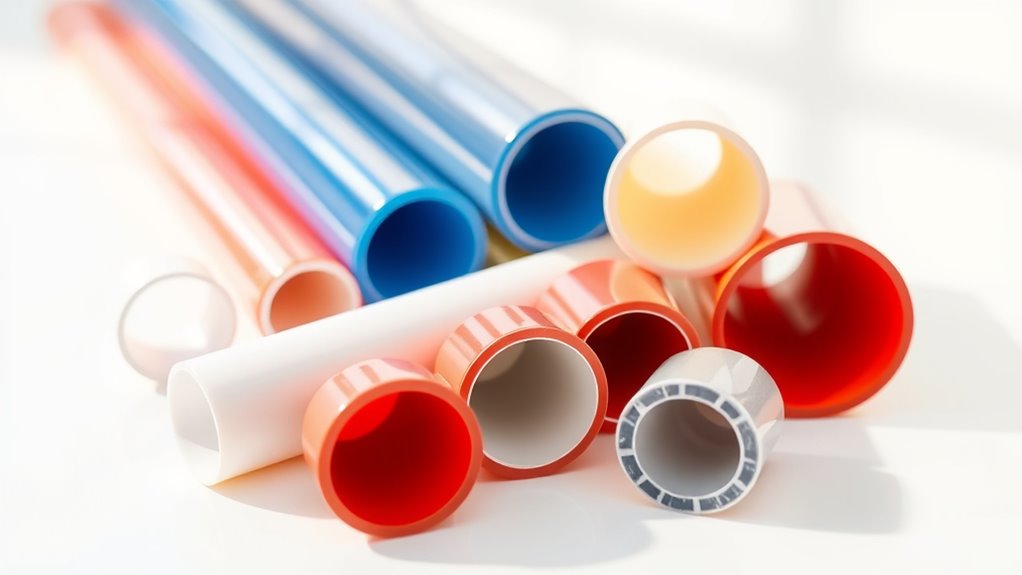What Is PEX Pipe Made Of? Materials and Manufacturing Process Explained
PEX pipe, or cross-linked polyethylene pipe, is made from high-density polyethylene (HDPE). The manufacturing process involves extruding HDPE into pipe form and then cross-linking it using peroxide or silane methods. This process enhances the pipe’s flexibility and durability, making it resistant to corrosion, high temperatures, and bacteria. PEX is versatile for various plumbing applications, and ongoing eco-friendly innovations are anticipated. For more details on the benefits and types of PEX pipe, further exploration is encouraged.
Overview of PEX Pipe

PEX pipe, or cross-linked polyethylene pipe, is a popular choice for plumbing due to its flexibility and durability.
It can easily bend around corners, making installation straightforward and minimizing the need for additional fittings. This feature makes it suitable for both residential and commercial plumbing systems, including water supply lines and radiant heating.
PEX is resistant to corrosion and scaling, which enhances its longevity compared to traditional materials like copper or PVC. Additionally, it performs well in freezing temperatures, reducing the risk of bursting in colder climates.
Chemical Composition of PEX
The chemical composition of PEX pipe is primarily cross-linked polyethylene, which significantly enhances its thermal and mechanical properties.
This cross-linking improves resistance to temperature changes and pressure, making PEX ideal for plumbing applications.
PEX is produced using one of three methods: peroxide, silane, or electron beam, each affecting the material’s characteristics.
Additionally, PEX includes additives like stabilizers and antioxidants to protect against UV degradation and enhance functionality.
This composition ensures PEX’s durability and versatility in plumbing systems.
Types of PEX Materials
When selecting PEX materials for plumbing or heating applications, it’s important to understand the three main types: PEX-a, PEX-b, and PEX-c.
Each type is distinguished by its manufacturing process, resulting in differences in flexibility, temperature resistance, and durability.
- PEX-a: Offers the highest flexibility and resistance to cracking, making it ideal for areas with extreme temperature fluctuations.
- PEX-b: Known for its affordability and ease of installation, it’s suitable for most standard plumbing needs.
- PEX-c: Provides good chemical resistance and is often used in applications requiring higher pressure ratings.
Choosing the right type of PEX depends on your specific project requirements and environmental conditions.
PEX-a, PEX-b, PEX-c
When choosing between PEX-a, PEX-b, and PEX-c for your plumbing and heating needs, it’s essential to understand their distinct characteristics:
1. PEX-a: Made using the Engel method, this type is highly flexible and resistant to kinking, making it ideal for complex installations.
2. PEX-b: Created via the Silane method, PEX-b is known for its excellent chlorine resistance and is often used in larger diameter pipes.
It is also more cost-effective, making it suitable for budget-friendly projects.
3. PEX-c: Produced through irradiation, PEX-c offers good chemical resistance but is less flexible than PEX-a.
Each type serves specific applications, so choose based on your project’s requirements.
Cross-Linked Polymer Types
When it comes to cross-linked polymers, PEX (cross-linked polyethylene) is a popular choice for plumbing and heating systems.
There are three main types of PEX, each with unique manufacturing processes:
- PEX-a: Made using the Engel method with a peroxide process, PEX-a offers superior flexibility and crack resistance, making it ideal for applications requiring durability.
- PEX-b: Produced through a silane method, PEX-b is more cost-effective and provides good high-temperature resistance. However, it has slightly less flexibility than PEX-a.
- PEX-c: This type uses radiation cross-linking, striking a balance between performance and cost, with decent flexibility and temperature resistance.
Choosing the right PEX type depends on your specific plumbing or heating needs.
Cross-Linking Process in PEX

Cross-linking is crucial for enhancing the properties of PEX (cross-linked polyethylene). It involves creating bonds between polyethylene chains to form a three-dimensional network, significantly improving thermal stability, chemical resistance, and durability.
There are three main methods of cross-linking:
- Chemical Cross-Linking: Uses agents like peroxides or silanes.
- Physical Cross-Linking: Utilizes heat and pressure.
- Radiation Cross-Linking: Employs electron beams or gamma rays.
These methods significantly enhance the performance of PEX pipes, making them suitable for a variety of applications.
If you’re considering PEX for your project, understanding these cross-linking methods will help you choose the right material for your needs.
Benefits of Using PEX Pipe
PEX pipe has gained popularity in plumbing and heating due to its numerous advantages.
Its flexibility simplifies installation in tight spaces and reduces the need for multiple fittings. PEX is resistant to scale and chlorine, which helps prevent corrosion and extends its lifespan.
Additionally, its thermal insulation properties maintain water temperature, enhancing energy efficiency. Being lightweight makes transport and handling easier, and PEX is less likely to burst in freezing conditions compared to traditional piping materials.
These benefits make PEX an ideal choice for both residential and commercial plumbing projects, ensuring durability and performance.
Comparison of PEX With Other Pipe Materials
When considering plumbing materials, PEX pipe offers significant advantages over traditional options like copper and PVC. Here’s a quick comparison:
- Flexibility and Installation: PEX is flexible, making it easier to install and reducing labor costs compared to rigid materials like copper and PVC.
- Corrosion Resistance: Unlike copper, PEX is resistant to corrosion and does not require soldering, enhancing safety and user-friendliness.
- Energy Efficiency: PEX does not conduct heat as effectively as copper, potentially lowering energy bills for hot water systems.
- Durability in Extreme Temperatures: PEX outperforms PVC in extreme temperatures and can handle freezing conditions without cracking.
- Limitations: One downside is that PEX is not UV resistant, making it unsuitable for outdoor applications.
Manufacturing Process of PEX Pipe
PEX pipe is a popular choice for plumbing due to its unique properties, achieved through a specific manufacturing process. Here’s a concise breakdown of how PEX pipe is made:
| Step | Description | Purpose |
|---|---|---|
| Material Selection | High-density polyethylene (HDPE) is selected | Ensures durability and flexibility |
| Extrusion | HDPE is heated and formed into pipes | Creates the initial pipe structure |
| Cross-linking | Polymer chains are linked using methods like peroxide or silane | Improves strength and heat resistance |
| Finishing | Pipes are cooled and cut to desired lengths | Ready for distribution and use |
This process results in a flexible, durable pipe capable of withstanding high temperatures and pressures, meeting the needs of modern plumbing applications.
Quality Control in PEX Production
Ensuring the quality of PEX pipe during production is crucial for optimal performance and safety. Key quality control measures are implemented throughout the manufacturing process, starting with thorough testing of raw materials to ensure they meet industry standards.
During extrusion, critical parameters like temperature and pressure are meticulously monitored to maintain consistent wall thickness and structural integrity. Additionally, finished products undergo physical and chemical testing to assess their durability and resistance to environmental factors.
Random sampling is performed on each batch of PEX pipe to ensure uniformity and compliance with regulatory requirements. These quality control practices help manufacturers produce reliable PEX pipes that fulfill consumer expectations and adhere to industry standards.
Environmental Impact of PEX Pipe

When considering PEX pipe for plumbing and heating, it’s important to understand its environmental impact.
PEX is made from polyethylene, a plastic derived from fossil fuels, which contributes to greenhouse gas emissions during its production. The manufacturing process can also generate waste and pollutants that affect air and water quality.
While PEX is durable and can help reduce energy consumption in heating systems, it poses disposal challenges since it is not biodegradable and may contribute to landfill waste.
Recycling options for PEX are currently limited, but efforts are being made to improve this aspect.
Being aware of these environmental factors is crucial for making informed choices about using PEX pipe.
Applications of PEX Pipe
PEX pipe is a versatile solution widely used in plumbing systems due to its flexibility and corrosion resistance, making installation easier and more efficient.
It is also ideal for radiant heating systems, effectively warming floors with minimal energy loss.
Additionally, PEX is a reliable choice for distributing potable water, ensuring safe access to drinking water.
If you’re considering PEX for your project, its benefits in plumbing, heating, and water distribution make it a top choice.
Plumbing Systems Integration
As modern plumbing systems evolve, cross-linked polyethylene (PEX) pipe has become a popular choice for both residential and commercial applications.
PEX is ideal for water supply lines, drainage systems, and fire sprinkler systems due to its flexibility, which allows for easier routing and fewer fittings, thereby reducing the risk of leaks. Its resistance to corrosion and scale buildup ensures long-lasting performance.
Additionally, PEX’s lightweight nature simplifies transportation and installation, making it a preferred option among plumbers.
Withstanding temperature fluctuations and pressure changes, PEX enhances the efficiency and durability of plumbing systems.
Radiant Heating Solutions
PEX pipe is an ideal choice for radiant heating systems due to its flexibility, corrosion resistance, and efficient heat distribution.
This material allows for easy installation around obstacles, enabling various configurations that enhance comfort in both residential and commercial spaces.
Its thermal insulation properties reduce heat loss, improving energy efficiency.
With a long lifespan, PEX offers a reliable and sustainable heating solution, making it increasingly popular among builders and homeowners.
If you’re looking for an effective and cost-efficient option for your heating needs, consider using PEX in your radiant heating system.
Potable Water Distribution
Many plumbing professionals are choosing PEX pipe for potable water distribution due to its significant benefits. Here’s why PEX might be the right choice for your plumbing needs:
Key Advantages of PEX Pipe:
- Flexibility: PEX is highly flexible, making it easier to install in tight spaces compared to traditional materials.
- Corrosion Resistance: Unlike traditional pipes, PEX is resistant to corrosion, ensuring a longer lifespan.
- Installation Time: PEX installation is quicker, which can reduce labor costs.
- Cost Efficiency: While PEX may have a higher upfront cost, its durability and ease of installation can lead to overall savings.
These features make PEX an excellent option for both residential and commercial plumbing, ensuring safe and efficient potable water delivery.
If you’re looking for a reliable and modern solution, consider switching to PEX pipe.
Advantages of Cross-Linked Polyethylene
Cross-Linked Polyethylene (PEX) is an excellent choice for plumbing and heating systems due to its numerous benefits.
Its flexibility allows for simple installation around obstacles without requiring many fittings. PEX is resistant to scale and chlorine, minimizing corrosion risks, and it offers great thermal insulation, helping to maintain water temperature and reduce energy bills.
Additionally, PEX is lightweight and easy to transport, further simplifying the installation process. Its resistance to freezing also reduces the risk of bursting in cold weather.
These advantages make PEX increasingly popular among homeowners and plumbing professionals.
Common Myths About PEX Pipe
What are the common misconceptions about PEX pipes that could mislead consumers and professionals?
Here are some key clarifications to help you make informed decisions:
- Can PEX be used outdoors? While PEX is primarily designed for indoor use due to its vulnerability to UV damage, it can be used outdoors if properly protected from sunlight.
- Is PEX prone to bacteria growth? No, PEX is resistant to bacteria because its non-porous structure prevents build-up, making it a safe choice for plumbing.
- Does PEX have a shorter lifespan than metal pipes? Not necessarily. With proper installation and maintenance, PEX can last over 50 years, comparable to many metal pipes.
Understanding these facts can help you choose the right plumbing system for your needs.
Installation Process for PEX Systems
Installing a PEX system may seem challenging, but it’s actually quite simple and can be done by both professionals and experienced DIYers. Here’s a quick guide to get you started:
- Plan Your Layout: Before starting, sketch out the layout of your PEX system and gather all necessary materials, including PEX tubing, fittings, and tools.
- Cut and Connect: Cut the tubing to the appropriate lengths. Use crimping or clamping methods to connect the tubing to fittings securely.
- Flexibility: Take advantage of PEX’s flexibility to navigate around obstacles easily.
- Pressure-Test: After installation, pressure-test the system to ensure there are no leaks.
- Insulate if Necessary: Consider insulating the system to maintain temperature control.
With these steps, you can efficiently install a PEX system in less time than traditional piping methods.
Maintenance of PEX Pipe
To maintain PEX pipes effectively and ensure their longevity, follow these key practices:
- Regular Inspections: Check for leaks, cracks, or signs of wear. Early detection can prevent costly repairs.
- Cleaning: Keep the pipes free of debris and sediment to maintain water quality and flow efficiency.
- Timely Repairs: Address any issues immediately to avoid larger problems down the line.
Regular Inspections Required
Regular inspections of PEX pipes are crucial for ensuring their longevity and functionality. Neglecting these checks can lead to water damage and costly repairs.
Here are key points to focus on during inspections:
- Check for damage: Look for cracks, discoloration, or leaks.
- Inspect connections: Ensure all joints and fittings are secure and corrosion-free.
- Assess environmental exposure: Verify that pipes are not subjected to extreme temperatures or harmful chemicals.
Conducting these inspections periodically can help identify issues early and maintain system efficiency.
Cleaning and Repairs
Routine inspections are crucial for maintaining PEX pipes. Regularly check for leaks, discoloration, or unusual odors to catch issues early.
For cleaning, use a gentle soap solution with a soft cloth or sponge. For tougher stains, specialized PEX cleaning solutions can be applied carefully.
When repairs are needed, always use manufacturer-approved fittings and connectors to ensure compatibility. In cases of significant damage, replacing the affected section of PEX is usually more effective than patching.
Regular maintenance not only enhances the longevity of your PEX plumbing system but also ensures reliable performance over time.
Future Trends in PEX Technology
What are the future innovations in PEX technology? As PEX becomes increasingly popular in plumbing and heating, several key trends are emerging:
- Smart PEX Systems: These systems integrate sensors for real-time monitoring of water quality and pressure, enhancing system management.
- Sustainable Materials: New eco-friendly PEX formulations are being developed to minimize environmental impact.
- Enhanced Durability: Improvements in cross-linking techniques are making PEX more resistant to temperature changes and chemical exposure.
These advancements are designed to boost the performance of PEX pipes while meeting environmental standards and consumer needs, making the future of PEX technology both efficient and sustainable.
Conclusion
PEX pipe, made from cross-linked polyethylene, is a popular choice in plumbing due to its flexibility and resistance to scale and chlorine. It’s projected that the global PEX market will reach $2.5 billion by 2026, indicating a strong demand in the construction industry. As technology evolves, PEX is set to enhance efficiency and sustainability in plumbing solutions.




